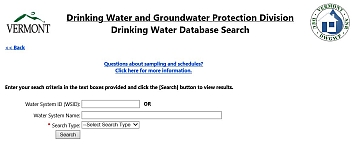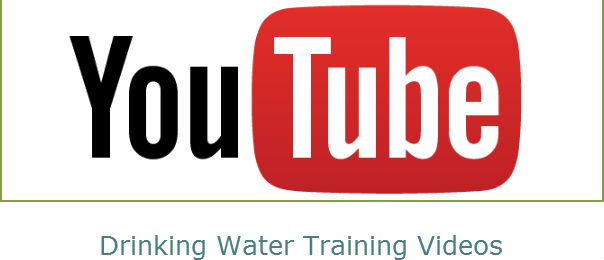The Environmental Protection Agency defines a sanitary survey as “an onsite review of the water source, facilities, equipment, operation, and maintenance of a Public Water System for the purpose of evaluating the adequacy of such source, facilities, equipment, operation and maintenance for producing and distributing safe drinking water.” (40 CFR) The purpose of a sanitary survey is to ensure that the water system is operating in a manner that provides safe drinking water from the source to the tap. Transient Non-Community water systems are required to have a sanitary survey at a minimum of once every five years. The sanitary survey will be scheduled conducted by staff in the TNC Program.
What Can I Expect?
A member of the TNC Program will contact you to schedule a survey of your water system. Surveys are usually scheduled one to two weeks from the date you were contacted by the Division. You should expect to spend time with a surveyor reviewing your system, walking through components, reviewing system related reports and documentation, and answering any questions the surveyor may have. Depending on the size of your system, the inspection can take anywhere from ½ hour to several hours.
At a minimum the survey will address the following eight sanitary survey components:
- Source
- Treatment
- Distribution system
- Finished water storage
- Pumps, pump facilities, and controls
- Monitoring, reporting, and data verification
- System management and operation
- Operator compliance with State requirements
Following the survey, the Division will issue a letter to the water system which identifies the findings of the survey and includes a compliance schedule to address any deficiencies identified during the survey. System deficiencies need to be corrected in accordance with a schedule approved by the Division. The State may conduct more frequent sanitary surveys for any system. Public water systems must provide the State, at the State’s request, any information that will enable the State to conduct a Sanitary Survey. (CFR 141.402)
How Can I Prepare?
Once your survey is scheduled you can do the following to be prepared for an inspection of your facility:
Provide Access:
Understand where your source, pumps, storage tanks, treatment facilities, and service connections are located. Ensure that you can provide adequate access to these components at the time of the survey.
Gather Documentation
Come prepared to the survey with documentation that relates to your public water system. This may include:
- Operating Permits
- Operator Certification documents
- Sampling Plans
- Water quality lab reports
- Monthly Operation Reports
- Source and Construction Permits
- Regional Office Permits
- Water system layout and engineering drawings
- Source information and well completion reports
- Storage tank capacity(s)
- Storage tank cleaning and inspection reports
- Pipe sizes and construction material
- Treatment plant product manuals and chemical dosage rates
- Well pump and booster pump rates
- Number of service connections and population served
- Historical survey letters
- Documented water system changes
- Division correspondence
Inform Your Staff
Notify all of the appropriate individuals that are involved with management and operations of the drinking water system at the facility that Division will be on-site to conduct a sanitary survey. This may include property owners, water system operators, maintenance staff, and property caretakers.
Clean Up!
The intent of the sanitary survey is to identify unsanitary conditions that may contribute to negative water quality – clean up any unsanitary conditions! Remove garbage, dust, insects, rodents, and debris found throughout areas that come in contact with your water system.
Know the Flow:
Perform a walkthrough of the water system prior to the survey. Know the flow of water at your facility from the source to the tap. Look for any potential deficiencies or pathways for contamination that can be eliminated prior to the survey.
Source:
Whether it is a drilled well, a spring, or a surface water intake, know where the source of your water system is located. Make sure you are capable of providing access to the site. Open any heavy concrete lids, manhole covers, or hatches before the survey or have the tools or keys available to open them during the survey. If you have a well pump, know the flow rate.
Treatment:
Know where the treatment facilities are located, what type of treatment the water system utilizes, and what contaminants are treated for. Be familiar with any point-of-use filters or water softeners located at the system. If utilizing a chemical injection system such as chlorine disinfection or pH control, know the dosage rates. Know the manufacturer and model numbers for chemical injection pumps, filtration systems, and other treatment equipment. Know how often and at what rate your filtration systems backwash. Identify the location of the backwash discharge. Know how often your treatment plant is serviced.
Finished Water Storage:
Be able to provide access to the finished water storage tank. Know where the tank is located, the tank capacity, and how water is served from the tank. Know where the tank overflows, vents, manways, and drains are located. Open any heavy concrete lids, manhole covers, or hatches covering the storage tank before the survey or have the tools or keys available to open them during the survey.
Pumps, Pump Facilities, and Controls:
Know what pumps are utilized and where they are located at your water system. Know the flow rate and operation of those pumps.
Distribution System and Sampling Locations:
Prior to the sanitary survey ensure that you are familiar with the connections (buildings, hydrants, yard spigots) that are served by your water system. Know where the distribution lines are located, line sizes, and the material of construction. Know and be able to provide access to your sampling locations and locations where daily chlorine readings are taken. Be prepared with sampling questions if you are interested in reviewing sample site selection and protocol during the survey.
Monitoring, Reporting, and Data Verification:
Save all of your lab reports and monitoring schedules. Verify that you are in compliance with your current monitoring schedule. Ensure that you are completing and submitting your monthly reports.
System Management, Operation, and Operator Compliance:
Know the status of your Operating Permit. Ensure the water system has a Certified Operator of appropriate class. Be familiar with any recent maintenance or changes that have occurred at the facility. Know the routine and preventative maintenance practices.
Eliminate the Pathways of Contamination:
During your pre-survey walk-through, eliminate any potential pathways of contamination. A list of common deficiencies that are identified during a survey is coming soon!
The Level 1 Assessment Form required under the Revised Total Coliform Rule serves as a good pre-survey walk through tool!


